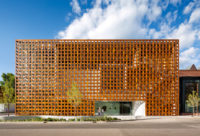In Aspen, Demolition Looms for Modernist Building by Harry Weese
A little-known building in Aspen, Colorado, designed by the late Chicago architect Harry Weese—whose most celebrated work is the Washington, D.C., Metro system—is threatened with demolition.
Built in 1972, Weese’s Given Institute is a small concrete-block conference center owned by the University of Colorado School of Medicine. The 12,000-square-foot structure sits on a 2.25-acre lot in Aspen’s pricey West End residential neighborhood. For years, the medical school has used the institute for summer conferences and retreats, but faced with ongoing budget cuts, it now plans to close the Given and sell the property. School officials are negotiating with a potential buyer, who has offered $15 million for the property—provided Weese’s building is torn down.


The city of Aspen hopes to save the building. Amy Guthrie, Aspen’s historic preservation officer, says the Given is part of the town’s rich cultural history. “This isn’t just some random, nice modernist building that appeared here,” she says. “It really is directly tied to the community’s history as a cultural and intellectual center.”
Voters May Decide
Aspen voters may have the chance to decide in November whether the city should spend tax dollars to buy the Given. But that could be a hard sell in the current economy, says Ziska Childs, a production designer and preservationist who started a “Help Save the Given Institute” Facebook page.
“I don’t think there’s any chance of it passing,” Childs says. She points out that because of the Given’s relatively isolated location and limited use, many Aspenites don’t even know it exists—which has made it difficult to rally support for saving the building.
City council members have already rejected one plan that would have asked voters to allow the city to match the $15 million offer to buy the Given. A new proposal could still end up on the November ballot, however.
Weese in the Spotlight
The dispute over the Given comes at a time of renewed interest in Weese, who died in 1998. A recent article in Chicago magazine chronicled the architect’s thriving career in the 1960s and 1970s and his alcohol-fueled decline. And architectural historian Robert Bruegmann has written the forthcoming book The Architecture of Harry Weese, the first critical study of the architect’s work.
Born in Evanston, Illinois, in 1915, Weese studied city planning under Eliel Saarinen at the Cranbrook Academy of Art in Bloomfield Hills, Michigan. After working for a year in Skidmore, Owings & Merrill’s Chicago office, Weese opened his own practice in 1947. Although considered a modernist, Weese rejected the minimalist style of Chicago’s preeminent post-war architect, Ludwig Mies van der Rohe, preferring a more eclectic, expressionistic approach. In addition to the Washington Metro, Weese designed the brutalist Arena Stage, also in Washington, D.C., and the Time-Life Building in Chicago.
The Given's Project
Bruegmann says Weese first visited Aspen shortly after World War II ended. In 1968, he and his wife, Kitty, bought a house in the ski town. Weese became friends with Walter and Elizabeth Paepcke, who had helped transformed Aspen into a thriving cultural center by founding the Aspen Institute and the Aspen Music Festival and School. (They hired Bauhaus architect Herbert Bayer to design the institute’s buildings.) Elizabeth Paepcke commissioned Weese to design the Given Institute, which was built on property that she donated to the University of Colorado School of Medicine.
Bruegmann calls the Given one of Weese’s most important works, and it is one of 31 projects by Weese featured in his new book about the architect. “It’s a quirky building that shows the whimsical side of Harry,” Bruegmann says. “To tear it down would be an act of cultural vandalism.”




